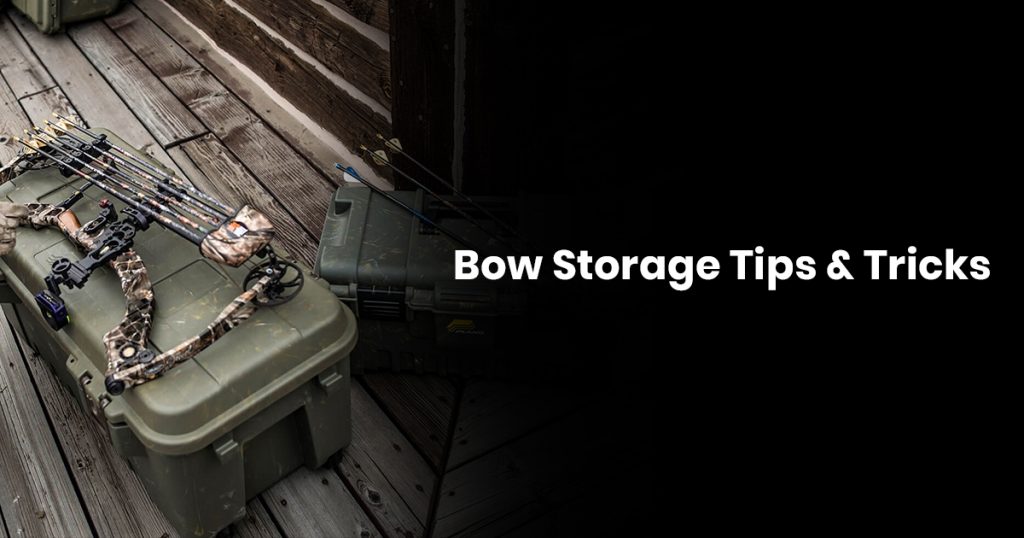Your bow is more than a weapon.
It is a work of art, and quite a delicate one at that.
Keeping your bow pristine requires storing it properly so find a great place close by.
When you do, not only will you be able to get a lifetime’s use out of it, you’ll even be able to hand it down for the first time to the next generation of archer.
In this article, we provide you with a range of tips and tricks to help you best store all bow types.
Why Worry About Bow Storage?
There are many things you can do to damage your bow.
The biggest things include dry firing, stringing the bow backwards, leaving it out in inclement weather and lending it to a friend who’s heavier than you are.
However, one of the most common causes of bow deterioration has to do with bow storage.
If you keep it in the garage, attic or the back of the car, the bow could warp, which will make it virtually unusable.
That’s why bow storage is such an important issue.
The Bow Case
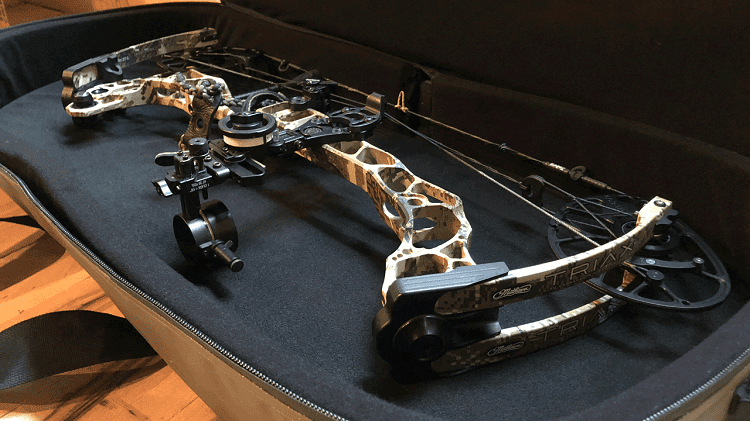
Archers and bowhunters who use a take-down bow should invest in a bow case.
This will provide the best protection from the elements and from general wear and tear.
Bow cases come in a number of different materials and configurations.
As well as cases that are designed for take-down bows, you can also get them for longbows, compounds and recurve bows.
However, these are rarer and harder to find than cases for take-down bows.
When shopping for a bow case, you should invest in the best case you can afford.
Paying an extra hundred or so dollars will cause temporary financial pain so decide early how serious are you with this Archery hobby.
But the benefits in the long-run will far outweigh that pain.
Knowing that your archery equipment is safe and sound no matter where you happen to be travelling, will be well worth it.
Bow Case Buyer’s Guide
The first buying consideration for a bow case will be durability.
The best type of case for this will be a hard shell case.
It should have inside supporting posts to prevent the possibility of the case being crushed.
Make sure that the case is securely lockable with solid latches.
It should also be waterproof and have a comfortable ergonomic handle.
You may even want to invest in a case that has wheels so that you can roll it through the airport.
You also want a case that is lightweight.
Your bow case should also house your arrows.
Look for a cause that provides a separate compartment for each arrow to keep them secure and separate.
Arrows should be individually cushioned and mounted.
Check, too, that the fletchings have clearance so they are not damaged while in storage.
Expect the storage case to also be able to take your broadheads, knife, replacement parts, glove, and arm-band.
Each of these should have its own dedicated storage space.
You can buy a double bow case.
This is ideal if you have two take-down bows and if you are planning a hunting trip during which you’ll be hunting for different types of game depending on your skill level.
This may require the use of two bows.
Taking a second as a matter of course in case your primary bow gets damaged is always a smart idea, especially if you are investing a large amount of money on your hunting trip.
Types of Bow Cases
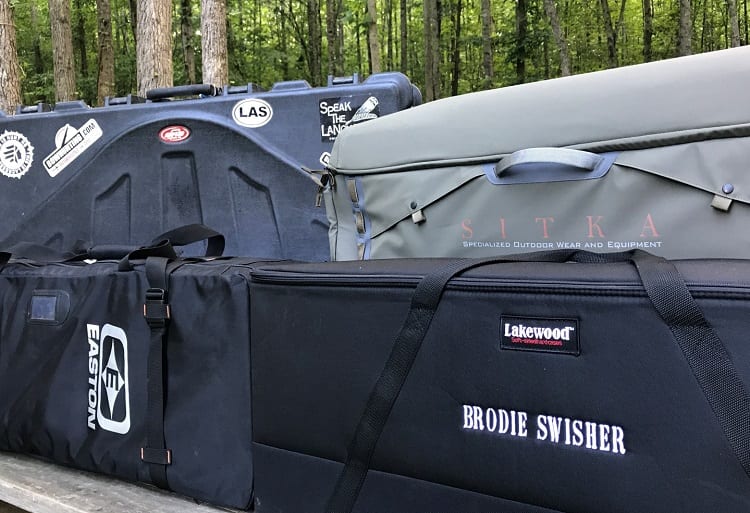
Soft Bow Case
Soft, padded bow cases are suitable for short hunting trips and for keeping your take-down bow in storage.
However, they are not as good as hard shell cases at protecting your bow from some dropping on the case.
Soft bow cases are made from a cloth material and have zipper openings.
Many of them are lockable.
You can get a soft case for a take-down, recurve or compound bow.
The shape of the case will conform to the type of bow.
Some soft cases will provide you with arrow storage.
If not, you can always get an arrow tube and pack it inside the case along with the bow and other equipment.
Backpack Case
A backpack case is ideal for storage of take-down bows.
The backpack allows you to pack in the limbs, riser, and sight.
You can also throw an arrow tube into the pack.
The ability to wear the pack on your back when in transit is very convenient.
Of course, there is no hard shell protection for your bow with a backpack bow case.
A backpack case is not a good choice for going on a plane.
You won’t be able to take it onto the plan as travel luggage.
However, it’s not suitable for storing in the cargo hold because it is not crush proof.
Hard Case
A hard case will provide you with the best protection for compound bows or recurve bows.
The majority of the cases are constructed from high-density plastic.
These are extremely durable.
A major benefit of a hard bow case is that it can be safely taken on a plane, which is not the case with other types of bow cases.
The majority of hard cases will come with foam inserts.
You are able to personally cut these inserts to fit your personal training equipment.
Wall Storage
If you have a recurve bow you can store it on the wall with pegs.
This should be in the driest part of your house.
Store the bow horizontally.
Remember, too, to store the bow unstrung.
A bow that is strung for a long time will put a lot of stress on the limbs, which could lead to cracking.
FAQ -Bow Storage Tips and Tricks
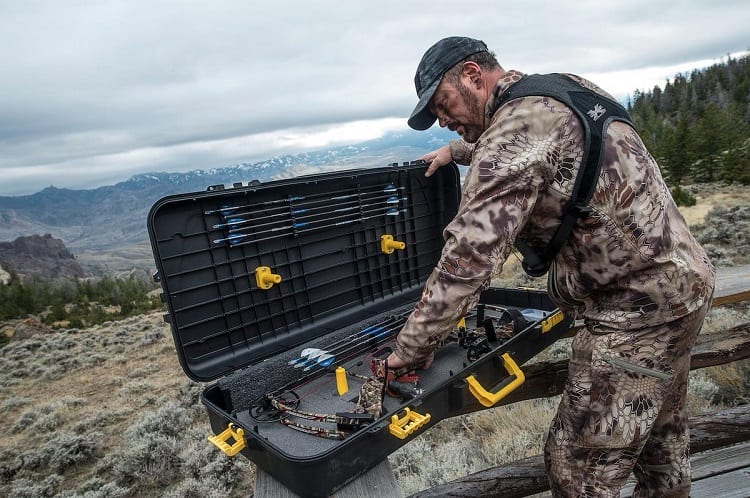
Should I Unstring My Bow for Storage?
Whether or not you unstring the bow when it is in storage depends on the type of bow.
A compound bow will remain fully strung at all times.
As a result, the case needs to be big enough to accommodate the full shooting size of the bow.
However, take-down and recurve bows need to unstrung after every use.
How Many Cases Should I Have?
This question often arises when an archer starts buying more expensive accessories, such as sights.
High quality gear will often come with its own carry case.
As a result, you can end up with a number of extra cases in addition to your bow case.
Having all of these cases, though, can get quite messy – and it can be easy to leave one of them behind.
That is why we recommend doing away with the extra cases and keeping everything together in your bow case.
Should I Have a Tackle Box?
Yes, it is definitely a good idea to have a tackle box in which to keep your bits and pieces.
This should include such things as wrenches, nocks, screws, glue, serving thread and other tools which are needed to fix your arrows.
This should be packed into your bow case, so make sure that you have enough room for it in there.
Do I need a gun safe to store my bow?
No, you do not need a gun safe to store your bow.
However, it is a good idea to keep your bow inside a lockable bow case.
How Should I Store My Arrows?
Your arrows are even more prone to damage than your bow is.
An arrow that is damaged, especially in the fletching area, will never fly true.
That makes it very important that you store your arrows correctly.
You should store your arrows in your quiver.
However, a quiver should hold no more than 8-10 arrows.
More than that and you risk damage from the fletchings rubbing against each other.
You can also use an arrow divider.
This will keep all of your arrows separate and secure.
Make sure, however, that you use a foam divider rather than a plastic one.
Plastic dividers are likely to leave an indentation on the shaft of the arrow.
- Bow Storage Tip:
- Never leave your bow exposed to the sun in a hot car.
- Also don’t store it in a damp place, such as a basement or shed.
- The extremeties in temperature and the moisture can actually cause the limbs to warp.
Archery Storage Hacks
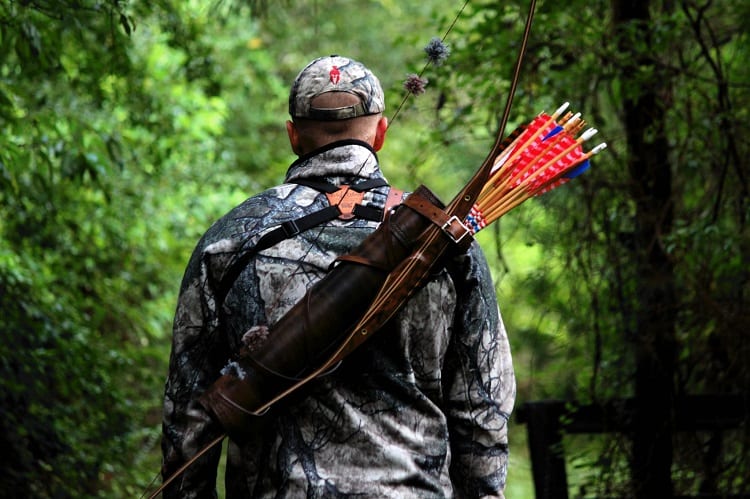
-
- Use a pair of suspenders to turn a hip quiver into a back quiver.
- Clip the top suspender clips to the top of the quiver.
- Then attach one of the bottom clips to the bottom of the quiver.
- Now slip the quiver over your head and then clip the final clip at the back.
- Pick up a free-standing full-length cupboard from a yard sale and convert it into your bow storage compartment.
- Take out all the shelves.
- Use curtain rods to hold your bows.
- A second curtain rod at the back can hold your strings and stringers.
- Place your arrows in a plastic tube or compartmentalized cardboard box.
- Buy a few Command hooks to allow you to store your gloves, tabs, and arm-bands.
- You can also use rubber wire organizers (which you can pick up at Staples stores) to hold your broadhead arrows.
- These will hold your broadheads in an upright position individually so there is no risk of damage to them.
- To take an arrow you simply give it a pull.
- Use an old pair of jeans top make a bow sock. Sew the legs together and along the bottom to make a secure pouch.
- Secure one end with a strip of leather.
- Finally, attach a or gun sling so that you can wear it over your shoulder.
So What Are You Going To Do Next Time
Storing your bow and other archery equipment properly will preserve your gear so you can enjoy it for many years to come.
Follow our trick and tips to make sure that the way you store your bow is preserving rather than diminishing its value.

